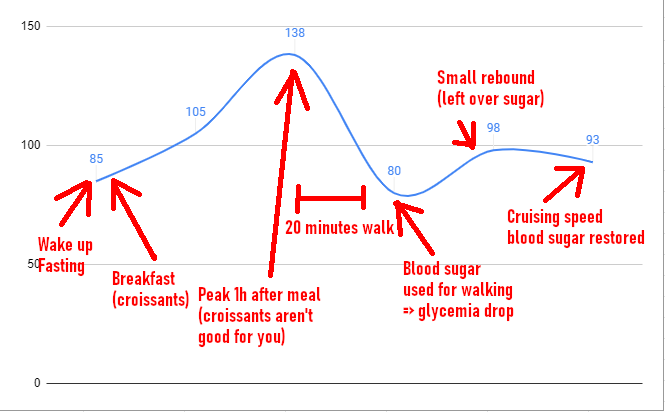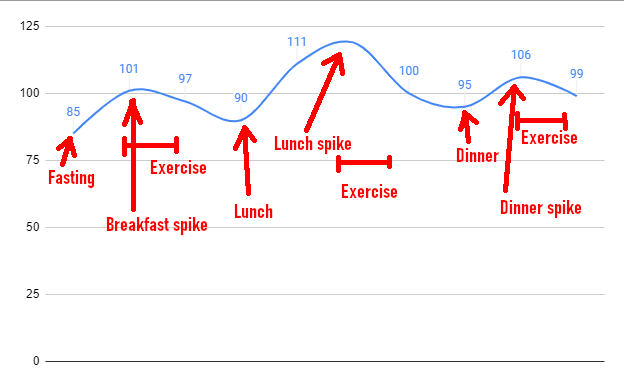So you want to eat something you know is bad for you? For example a croissant for breakfast once in a while. Or a slice of chocolate cake. You know they’re going to make you spike badly. But sometimes it’s hard to resist (or you have no choice because you can’t control the food you’re going to eat).
The principle for me is that once you eat, your body will extract all the carbs it can and convert them to glucose very quickly. That glucose will end up in your blood stream within an hour after you eat. If you let things happen naturally, your body is going to secrete insulin to force that glucose into short term storage (cells, muscles), and then it will need to store the excess in long term storage (fat is the only option here). But if you find a way to use that glucose before it has time to be stored, you avoid both the blood sugar spike and putting on weight.
One easy way to control your glycemia is exercise. It doesn’t have to be super intense (my wife loves her HIIT, I don’t like it). When I started my journey with diabetes, I was walking 10 minutes. Over time, with weight loss, it became 20-25 minutes running. You don’t need to be an exercise nut, just do some.
As you start exercising, your body uses glycogen (glucose derivative stored in muscles) to fuel your needs. Once these reserves are depleted (they don’t last long), your muscles will use the glucose in your blood. That’s what is interesting for us diabetics as this removes excess glucose from the bloodstream very quickly before it needs to be stored anywhere and before it requires insulin secretion. Then eventually, fat reserves will be called in (that’s where you lose weight and fat deposits), and in abnormal situations proteins from muscles (if I remember my biology classes right).
The graph below shows my glycemia one morning I had croissants for breakfast (only 3 times in the last 6 months, I try to be good). As you can see, my fasting blood sugar level was 85mg/dl, which went up quickly all the way to 138mg/dl one hour after breakfast. To control that, I normally exercise 45 minutes after a meal. On that day I was a bit late, which is why the spike is a bit higher than usual. But after a 20 minutes walk, my blood sugar dropped to 80mg/dl. I had used all the sugar in my blood stream (and possibly called on some reserves). 2 hours after the meal, there was a small rebound to 98mg/dl because my body was finishing to extract glucose from those croissants, which came down again to 93mg/dl quickly on its own.

Exercise after meals doesn’t have to be limited to bad meals. You can do it systematically (I run 20-25 minutes after all 3 meals of the day). The advantage is a tight control of your blood sugar and weight loss due to exercise (get to over 10,000 steps every day). On most normal days with a normal diet, I don’t spike above 120mg/dl. Often not above 110mg/dl.

There are other ways to control glycemia, but exercise is a very easy and very effective one.
Again, it’s not just my grand mother that says so. If you want to learn about the scientific aspect, several papers have been published on the subject: here, here, or here for example. Studies have even shown that exercise improves insulin sensitivity.



